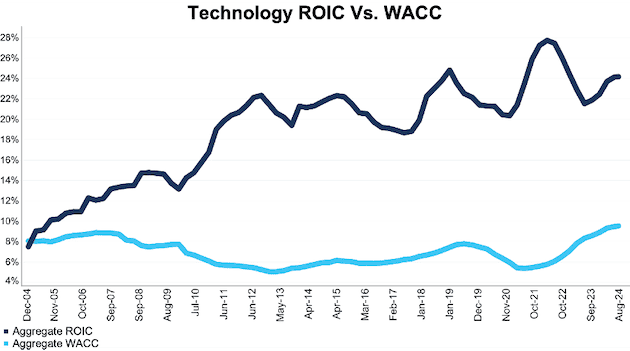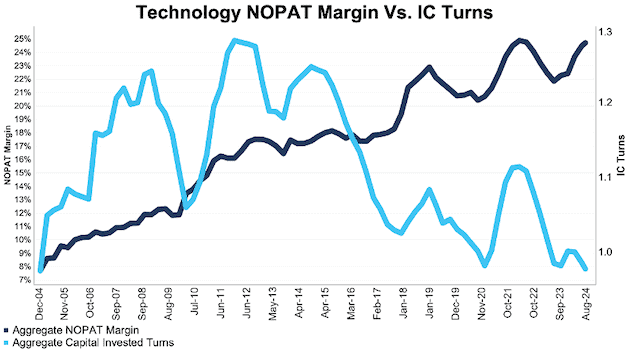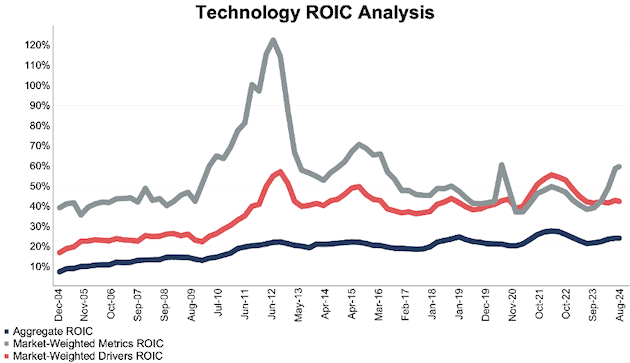We have updated the trailing-twelve-month (TTM) return on invested capital (ROIC) for the S&P 500 and all sectors for 2Q24. No matter the trend for the index, beneath the surface, performance by sector varies quite a lot. Some sectors saw ROIC rise while others saw it fall. The deeper we dig, the bigger the differences. For example, NOPAT margins and invested capital turns (the key drivers or ROIC), we see wildly different results in different sectors.
Six out of eleven S&P 500 sectors saw a QoQ rise in ROIC in 2Q24.
This report is a free and abridged version of S&P 500 & Sectors: ROIC Update for 2Q24, one of our quarterly reports on fundamental market and sector trends. The full report is available to our Institutional members.
The full version of this report presents the drivers[1],[2] of economic earnings [ROIC, NOPAT margin, invested capital turns, and weighted average cost of capital (WACC)] for the S&P 500 and each of its sectors (last analysis is here). You can find the our macro analysis on other key metrics here.
This report leverages our cutting-edge Robo-Analyst technology to deliver proven-superior[3] fundamental research and support more cost-effective fulfillment of the fiduciary duty of care.
S&P 500 ROIC Analysis for 2Q24
Figure 1 in the full report shows the S&P 500’s ROIC every quarter over the last twenty years. We provide the same analysis for the NOPAT margin and invested capital turns for the S&P 500 and its eleven sectors.
Key observations:
The S&P 500’s NOPAT margin remains well above the historical average of since 2004. See Figure 17 in the full report for details. Balance sheet efficiency may have stalled, as invested capital turns have remained at the same level for each of the past four quarters. We have to look back to early 2013 to find a time when invested capital turns were higher. In other words, to drive ROIC higher, companies must drive invested capital turns up past record levels and/or drive NOPAT margins back near the post-COVID record levels.
WACC for the S&P 500 rose QoQ again in 2Q24, the eleventh QoQ increase in the past twelve quarters. With expectations for rate cuts in the coming months, WACC could see some easing, but we except it to remain high for the foreseeable future. The high cost of capital undermines the ability of many weaker companies to fund poor business models with cheap capital.
See Figure 1 in the full version of our report for the chart of ROIC and WACC for the S&P 500 from December 2004 through 8/15/24.
Sneak Peak on Select S&P 500 Sectors
The Technology sector performed best in the second quarter of 2024 as measured by change in ROIC. The biggest loser in the first quarter was the Industrials sector.
To give you a sense of what we show in the full report, we provide a snippet on the Technology sector, below.
The full report provides these details and charts on the S&P 500 and all sectors.
Sample Sector Analysis[4]: Technology
Figure 1 shows the Technology sector’s ROIC rose from 23.8% in 1Q24 to 24.2% in 2Q24. The Technology sector’s NOPAT margin rose from 24.1% in 1Q24 to 24.7% in 2Q24, while invested capital turns fell from 0.99 in 1Q24 to 0.98 in 2Q24.
Figure 1: Technology ROIC vs. WACC: December 2004 – 8/15/24
Sources: New Constructs, LLC and company filings.
The August 15, 2024 measurement period uses price data as of that date for our WACC calculation and incorporates the financial data from 2Q24 10-Qs for ROIC, as this is the earliest date for which all the 2Q24 10-Qs for the S&P 500 constituents were available.
Figure 2 compares the trends for NOPAT margin and invested capital turns for the Technology sector since 2004. We sum the individual Technology sector constituent values for revenue, NOPAT, and invested capital to calculate these metrics. We call this approach the “Aggregate” methodology.
Figure 2: Technology NOPAT Margin and IC Turns: December 2004 – 8/15/24
Sources: New Constructs, LLC and company filings.
The August 15, 2024 measurement period uses price data as of that date for our WACC calculation and incorporates the financial data from 2Q24 10-Qs for ROIC, as this is the earliest date for which all the 2Q24 10-Qs for the S&P 500 constituents were available.
The Aggregate methodology provides a straightforward look at the entire sector, regardless of market cap or index weighting. The methodology matches how S&P Global (SPGI) calculates metrics for the S&P 500.
For additional perspective, we compare the Aggregate method for ROIC with two market-weighted methodologies: market-weighted metrics and market-weighted drivers. Each method has its pros and cons, which are detailed in the Appendix.
Figure 3 compares these three methods for calculating the Technology sector ROIC.
Figure 3: Technology ROIC Methodologies Compared: December 2004 – 8/15/24
Sources: New Constructs, LLC and company filings.
The August 15, 2024 measurement period uses price data as of that date for our WACC calculation and incorporates the financial data from 2Q24 10-Qs for ROIC, as this is the earliest date for which all the 2Q24 10-Qs for the S&P 500 constituents were available.
This article was originally published on August 28, 2024.
Disclosure: David Trainer, Kyle Guske II, and Hakan Salt receive no compensation to write about any specific stock, style, or theme.
Questions on this report or others? Join our online community and connect with us directly.
Appendix: Analyzing ROIC with Different Weighting Methodologies
We derive the metrics above by summing the individual S&P 500 constituent values for revenue, NOPAT, and invested capital to calculate the metrics presented. We call this approach the “Aggregate” methodology.
The Aggregate methodology provides a straightforward look at the entire sector, regardless of market cap or index weighting and matches how S&P Global (SPGI) calculates metrics for the S&P 500.
For additional perspective, we compare the Aggregate method for ROIC with two other market-weighted methodologies:
- Market-weighted metrics – calculated by market-cap-weighting the ROIC for the individual companies relative to their sector or the overall S&P 500 in each period. Details:
- Company weight equals the company’s market cap divided by the market cap of the S&P 500/its sector
- We multiply each company’s ROIC by its weight
- S&P 500/Sector ROIC equals the sum of the weighted ROICs for all the companies in the S&P 500/each sector
- Market-weighted drivers – calculated by market-cap-weighting the NOPAT and invested capital for the individual companies in each sector in each period. Details:
- Company weight equals the company’s market cap divided by the market cap of the S&P 500/its sector
- We multiply each company’s NOPAT and invested capital by its weight
- We sum the weighted NOPAT and invested capital for each company in the S&P 500/each sector to determine each sector’s weighted NOPAT and weighted invested capital
- S&P 500/Sector ROIC equals weighted sector NOPAT divided by weighted sector invested capital
Each methodology has its pros and cons, as outlined below:
Aggregate method
Pros:
- A straightforward look at the entire S&P 500/sector, regardless of company size or weighting.
- Matches how S&P Global calculates metrics for the S&P 500.
Cons:
- Vulnerable to impact of by companies entering/exiting the group of companies, which could unduly affect aggregate values despite the level of change from companies that remain in the group.
Market-weighted metrics method
Pros:
- Accounts for a firm’s size relative to the overall S&P 500/sector and weights its metrics accordingly.
Cons:
- Vulnerable to outsized impact of one or a few companies, as shown in the full report. This outsized impact tends to occur only for ratios where unusually small denominator values can create extremely high or low results.
Market-weighted drivers method
Pros:
- Accounts for a firm’s size relative to the overall S&P 500/sector and weights its NOPAT and invested capital accordingly.
- Mitigates potential outsized impact of one or a few companies by aggregating values that drive the ratio before calculating the ratio.
Cons:
- Can minimize the impact of period-over-period changes in smaller companies, as their impact on the overall sector NOPAT and invested capital is smaller.
[1] Calculated using SPGI’s methodology, which sums individual S&P 500 constituent values for NOPAT and invested capital. See Appendix III for more details on this “Aggregate” method and Appendix I for details on how we calculate WACC for the S&P 500 and each of its sectors.
[2] This report is based on the latest audited financial data available, which is the 2Q24 10-Q in most cases. Price data is as of 8/15/24.
[3] Our research utilizes our Core Earnings, a more reliable measure of profits, as proven in Core Earnings: New Data & Evidence, written by professors at Harvard Business School (HBS) & MIT Sloan and published in The Journal of Financial Economics.
[4] The full version of this report provides analysis for every sector like what we show for this sector.



